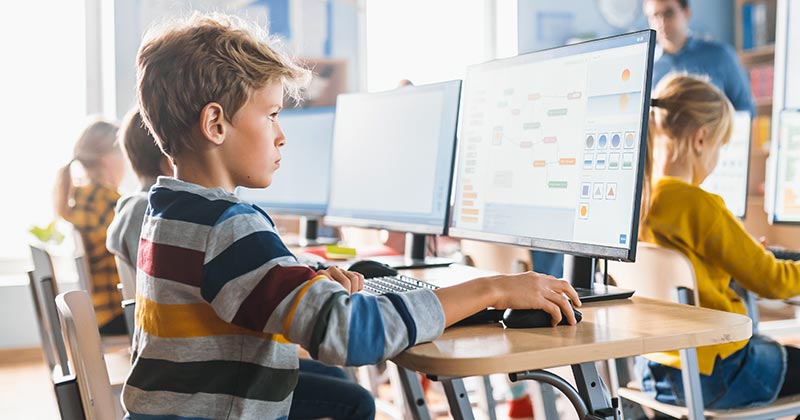Students who use various forms of technology in the classroom—including virtual classrooms—become actively involved in the learning objectives. The integration of technology facilitates the delivery of tailored education, which caters to each student’s specific needs while maintaining a more inclusive learning environment.
TECHNOLOGY INTEGRATION IN EDUCATION: WHAT DOES IT MEAN?
The use of technology to improve the educational experience for students is known as “technology integration in education.” Students who use various forms of technology in the classroom—including virtual classrooms—become actively involved in the learning objectives. The integration of technology facilitates the delivery of tailored education, which caters to each student’s specific needs while maintaining a more inclusive learning environment.
METHODS FOR INCLUDING TECHNOLOGY IN THE CLASSROOM
It’s a frequent misperception that integrating technology into the classroom will cost school districts money. Still, children don’t always need their computers or tablets to be successful in the digital age. For both auditory and visual learners, integrating technology into whole-class instruction can increase student engagement. Simple technological integrations in the classroom, such as PowerPoints, games, online homework assignments, or online grading systems, can have a significant impact on students’ development.
Games and PowerPoints
PowerPoint presentations can be used to interest students while introducing a concept being covered in class. Links to films that complement the concepts offered in the PowerPoint presentation can be integrated into the slides, in addition to the use of graphics and bulleted information.
Assignments for Internet Homework
Using learning management systems like Moodle, Blackboard, and Brightspace, teachers can begin integrating technology into the classroom by publishing homework assignments online. The ease of access to assignments can boost student participation and promote the organization.
Online assessment tools
Communication is an essential part of education since it allows teachers, administrators, parents, and students to discover a student’s areas of strength and growth.
Tablets in the classroom
If instructors are lucky enough to have tablets in their classrooms, technology can help them differentiate education throughout the curriculum. During assignments, students can work at their own pace, and teachers can provide one-on-one guidance.
AGE-GROUPS: STRATEGIES OF IMPLEMENTATION
Technology has several advantages that can improve any modern classroom. However, there will be variations in how technology is implemented and used in classrooms according to grade levels and topic areas.
How to Use Technology in Elementary School Classrooms
Younger pupils can use technology to develop the foundational abilities they’ll need for future independent study. Interactive games are a useful tool for teaching students reading, numeracy, spelling, and phonemic awareness.
TECHNICAL APPLICATIONS IN THE MIDDLE SCHOOL CLASSROOM
Students can use technology to acquire fundamental life skills as they start to transition into independent thinkers. Having separate teachers for each subject can help middle school students become more independent. It is possible to apply the use of technology to learn research skills in any subject field.
IN HIGH SCHOOL CLASSROOMS: TECHNOLOGY
After completing secondary school, pupils can learn how to use technology for their future careers and college study. Pupils who are comfortable with Google Drive and Microsoft Office get knowledge on how to make and share documents, construct spreadsheets, and provide and receive clear feedback on their work. Many professions use these Google and Microsoft features to manage information and facilitate collaboration among coworkers and clients.
WHY IS TECHNOLOGY IN THE CLASSROOM IMPORTANT?
When they provide students the chance to use technology in the classroom, teachers frequently experience success. When technology is utilised to teach in education, there are many advantages and consequences, and not all of them are good, according to some. One may argue that having an endless supply of entertainment and information available at all times is distracting. Still, when technology is used in the classroom in conjunction with established procedures that are evaluated or monitored, the benefits of its use exceed the drawbacks.
Keeping pupils interested
An essential component of any lesson plan is active engagement. Technology engages kids because it is participatory, regardless of whether they are working individually or in groups.
Aids pupils with various learning modalities
Not every student absorbs knowledge and retains it at the same rate or in the same manner. Teachers can use technology to adapt content to the right level of student learning and differentiate their education. Students can work at their own pace when using technology.
Give pupils life-skill preparation.
Since technology permeates every aspect of daily life, it has developed into a unique form of literacy in and of itself. A lot of professionals use Google Drive or Microsoft Office on a regular basis for at least one of the following tasks:
Making decks or slide shows for presentations.
Using spreadsheets to balance budgets.
Sending documents via email to convey crucial information.
Encouraging children to acquire and hone these abilities equips them for life after school.
For more info visit: https://drexel.edu/


